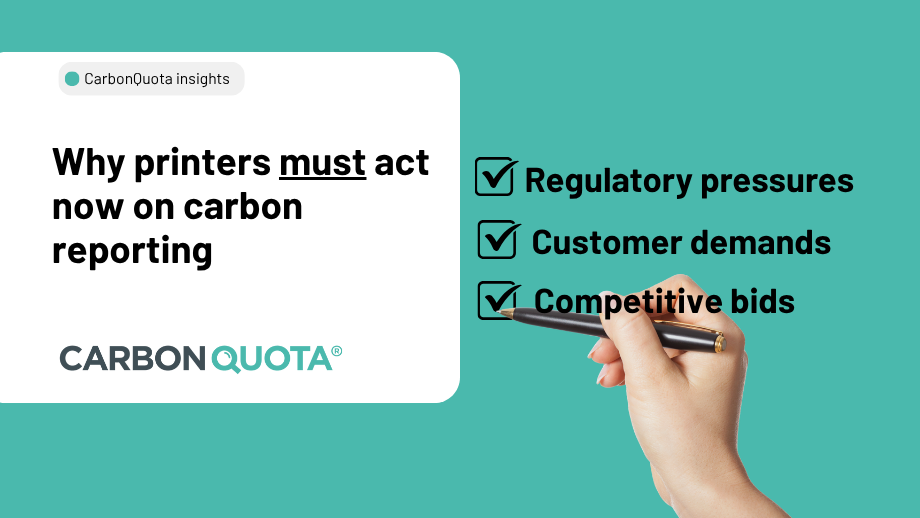The regulatory tide is rising. The print and packaging industry is entering a new era of accountability. What was once voluntary reporting has now evolved into mandatory disclosure – and for many printers, that shift is arriving sooner than expected.
Regulations such as the Corporate Sustainability Reporting Directive (CSRD) in the EU and the Streamlined Energy and Carbon Reporting (SECR) framework in the UK are transforming how businesses must measure, manage, and disclose their greenhouse gas emissions. These policies demand greater transparency – and crucially, they require activity-based carbon data, not generalised, spend-based estimates.
In the coming years, every printer supplying large brands or public sector clients will be expected to provide detailed, verifiable data about the carbon impact of their operations and products. Those unable to do so risk falling behind as customers prioritise compliant and transparent suppliers.
Many printing companies are delaying their response, assuming sustainability can be “handled later.” But in practice, carbon reporting is fast becoming a prerequisite for doing business.
The real risk isn’t regulation, it’s inaction
Many printing companies are delaying their response, assuming sustainability can be “handled later.” But in practice, carbon reporting is fast becoming a prerequisite for doing business. Large brands, from retailers to FMCG manufacturers, already require suppliers to provide accurate carbon data to support their own ESG frameworks and disclosure obligations.
The most competitive printers are already ahead of the curve – integrating carbon data collection into their management information systems (MIS) or ERP platforms, enabling them to report instantly and accurately. These businesses can show customers exactly how each product, process, or material contributes to their carbon footprint.
Those relying on manual data entry or generic calculators, however, face growing challenges. Incomplete or spend-based reporting not only risks non-compliance but also undermines customer trust and weakens commercial competitiveness.
Why automation is the turning point
Carbon reporting no longer needs to be complex or resource-intensive. Automated carbon measurement technology, such as CarbonQuota’s integrated platform, eliminates manual processes and delivers instant, audit-ready data.
By linking directly to your existing production and job-management systems, CarbonQuota’s technology measures the carbon footprint of every product and process, from energy use and material sourcing to transport. This makes it possible to generate detailed emissions data in seconds, directly within your existing workflow.
That same data can be used to:
- Meet regulatory obligations (CSRD, SECR, EUDR, and others)
- Support tenders and procurement submissions with verified figures
- Benchmark performance across jobs, sites or suppliers
- Identify reduction opportunities through actionable insights
Competitive advantage through credibility
Sustainability is no longer just about compliance – it’s a differentiator. Customers now expect partners who can demonstrate measurable progress, not just good intentions. Print businesses that embed structured carbon reporting are not only protecting themselves against regulation but also building long-term customer loyalty and trust.
For those who act early, there’s an additional advantage: operational efficiency. Automated data gathering reveals inefficiencies across energy, materials, and logistics that directly translate into cost savings. In other words, what’s good for the planet is increasingly good for business.
Sustainability is no longer just about compliance – it’s a differentiator. Customers now expect partners who can demonstrate measurable progress, not just good intentions.
The time to act is now. The transition to regulated carbon disclosure is accelerating – and waiting
Competitive advantage through credibility
Sustainability is no longer just about compliance – it’s a differentiator. Customers now expect partners who can demonstrate measurable progress, not just good intentions. Print businesses that embed structured carbon reporting are not only protecting themselves against regulation but also building long-term customer loyalty and trust.
For those who act early, there’s an additional advantage: operational efficiency. Automated data gathering reveals inefficiencies across energy, materials, and logistics that directly translate into cost savings. In other words, what’s good for the planet is increasingly good for business.
will only make the process more difficult later. Whether you’re preparing for CSRD, responding to customer data requests, or simply seeking to future-proof your operations, the essential first step is to establish an accurate, verifiable carbon baseline.
CarbonQuota helps printers do exactly that.
Our technology automates measurement, integrates seamlessly with leading industry MIS systems, and delivers carbon data in seconds – helping you move from reactive reporting to proactive, data-driven sustainability.
Contact CarbonQuota today to explore how automated carbon reporting can help your business stay compliant, credible, and competitive.



